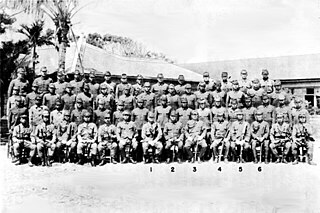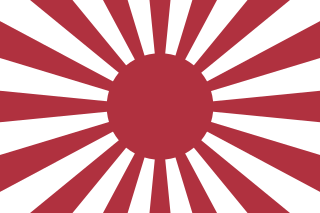
The Japanese 32nd Army was an army of the Imperial Japanese Army during the final stages of World War II. It was annihilated during the Battle of Okinawa.

The Japanese Imperial Guard is the name of two separate organizations dedicated to the protection of the Emperor of Japan and the Imperial Family, palaces and other imperial properties. The first was a quasi-independent branch of the Imperial Japanese Army which was dissolved at the end of World War II. The second is the Imperial Guard Headquarters, a civilian Imperial Guard formed as part of the National Police Agency.
This article covers the Japanese garrisons on the by-passed Pacific islands from 1944 to 1945, including the Japanese mandated territory of the South Pacific Mandate.

The Manchukuo Imperial Army was the ground force of the military of the Empire of Manchukuo, a puppet state established by Imperial Japan in Manchuria, a region of northeastern China. The force was primarily used for fighting against Communist and Nationalist guerrillas in Manchukuo but also took part in battle against the Soviet Red Army on several occasions. It initially consisted of former National Revolutionary Army troops of the "Young Marshal" Zhang Xueliang who were recruited after the Japanese invasion of Manchuria en masse, but eventually expanded to include new volunteers and conscripts. The Imperial Army increased in size from about 111,000 troops in 1933 to an estimated strength of between 170,000–220,000 soldiers at its peak in 1945, being composed of Han Chinese, Manchus, Mongols, Koreans, Japanese, and White Russians. Throughout its existence the majority of its troops were considered to be mostly unreliable by their Japanese officers and advisers, due to poor training, equipment, and morale.
Peiking Tientsin Operation from the Battle of Beiping-Tianjin in the Second Sino-Japanese War.
There were two 11th Independent Mixed Brigades in the Imperial Japanese Army.
The 1st Independent Mixed Brigade or 1st Mixed Brigade (獨立混成第1旅團) was an experimental combined arms formation of the Imperial Japanese Army. In July 1937, at the beginning of the Second Sino-Japanese War, the brigade was known as the Sakai Brigade, for its commander, Lt. General Koji Sakai. The brigade participated in Battle of Taiyuan in late 1937. After being promoted lieutenant general Masaomi Yasuoka took command from 1938 to 1939.
The 24th Division was an infantry division in the Imperial Japanese Army. Its callsign was the Mountain Division. The 24th Division was formed in Harbin, Manchukuo on 6 October 1939, as part of the Manchukuo territorial defense force under overall command of the 5th Army group of the Kwantung Army.
The 24th Mixed Brigade was a military unit of the Imperial Japanese Army.
The Imperial Japanese Army 18th Independent Mixed Brigade was an Independent Mixed Brigade formed November 7, 1939, in occupied China. It was assigned to the 11th Army. The unit was engaged in the Central Hupei Operation during the Second Sino-Japanese War. The brigade was re-organized as the 58th Division on 2 February 1942.

The Japanese Fourteenth Army was an army of the Imperial Japanese Army during World War II. On July 28, 1944 it was reinforced and upgraded to a field army called the Japanese Fourteenth Area Army, to counter the imminent Allied invasion of the Philippines by combined American and Filipino troops.
The Japanese 29th Army was an army of the Imperial Japanese Army occupying Malaya during the final days of World War II.
The following units and commanders fought in the Battle of Northern and Eastern Henan.
The second Guangxi campaign was fought between Japan and the Republic of China from late April to July, 1945.
Western Honan - N. Hupei Border Campaign
The 56th Independent Mixed Brigade was an Imperial Japanese Army unit of World War II. It was raised in June 1944 to reinforce the defences of Japanese-occupied Borneo, and was initially stationed in the north-east of the island. In early 1945 most of the brigade's units were ordered to move to the Brunei Bay area of west Borneo, with the brigade's personnel subsequently making a difficult march across the centre of the island.
The 62nd Division was an infantry division of the Imperial Japanese Army. Its call sign was the Stone Division. It was formed on 1 May 1943 at Taiyuan, simultaneously with the 63rd Division as a security division. The nucleus for the formation was the 4th and a part of the 6th Independent Mixed Brigades. As a security division, it lacked an artillery regiment. The division was initially assigned to the 1st Army.




